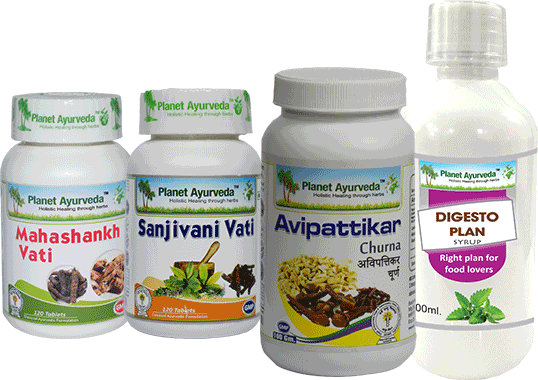Ayurvedic Treatment of Atrophic Gastritis in Antrum
Abstract
Atrophic gastritis or in short called AG develops when the lining of the stomach has been inflamed for several years. Th inflammation is generally the result of a chronic or long standing gastritis due to bacterial infection which is mostly caused by H.pylori bacterium. The bacteria generally disrupts the barrier of mucus which is responsible for protecting the lining of the stomach from the acidic juices that helps in digestion. If the infection grows gradually then it will destroy the cells of gastric mucosa and hence can result in Atrophic gastritis. In this article our main focus will be on the details regarding atrophic gastritis in antrum along with its best management in Ayurveda.
Introduction
Now as we know that the Atrophic gastritis in the antrum is the result of long standing gastritis caused by some specific bacterial infections like H.pylori. The best evidence today suggests that gastric atrophy is the end stage of a chronic inflammatory process starting with superficial gastritis and progressing through atrophic gastritis of increasing severity. Along with the increasing severity of inflammatory infiltrate and atrophy of the gastric glands, there occurs progressively more marked dysplasia and atypia of the surface epithelium. Dysplasia is generally understood as or refers to abnormal development of cells within tissues or organs. On the other hand, atypia of epithelium is described as the abnormal cells which can be in shape, colour, size or shape.

Pathogenesis of Atrophic gastritis in Antrum
The origin of chronic superficial gastritis is obscure except that it may simply represent an early stage of chronic atrophic gastritis. Autoantibodies against two separate components of the gastric parietal cell are present in such patients. Basically, Antral atrophic gastritis is type B gastritis and as the name suggests it involves Antrum of the stomach but does not spread to the body specifically along the lesser curvature and as mentioned before is the result of H.Pylori infection.
Causes of Atrophic gastritis in Antrum
Generally this type of Atrophic gastritis can be caused by persistent Helicobacter pylori infection. The long standing infection results in long term gastritis finally results in atrophy of gastric epithelium. If understood in Ayurvedic terms then following are the reasons for Atrophic gastritis in Antrum
Bsically, this condition is kept under anaveha strotas roga. The anaveha srotas starts from the mouth and is extended till caecum. Due to the reduced digestion power there is accumulation of endotoxins, these endotoxins then result in formation of gas and finally the process results in atrophic gastritis in the Antrum part of anaveha srotas. The most common cause of this diminishing agni and endotoxin accumulation are very common mistakes done by people like:
- Eating in excess on regular basis
- Disturbed timing to eat
- Eating nutrients deficient food
- Most importantly, a non-specific lifestyle
Symptoms of Atrophic gastritis
Patients generally present with common symptoms like
- Indigestion (apachi)
- Anorexia (aruchi)
- Incomplete digestion
- Nausea and vomiting
- Diminishing taste
- Restlessness
Most of the time the patient ignores recurrent indigestion, constipation and gastritis which gives it a chance to convert into chronic one. The relation of this condition directly with Helicobacter pylori infection is very commonly seen.
Diagnosis of Atrophic gastritis
There are two main methods which are used or are the methodological approaches for the evaluation of chronic atrophic gastritis are as follows:
- Invasive examination, which includes histological analysis of biopsy samples taken during upper digestive endoscopy and is the golden standard of diagnosis.
- Non invasive serological examination
Treatment of Atrophic gastritis
Generally for this condition antibiotics are prescribed as after examination its direct correlation is seen with Helicobacter pylori long term infection. Some medications are also prescribed to reduce the acid production in the stomach so the stomach has time to heal.
Ayurvedic treatment for Anaveha srotas vyadhi
Ayurvedic treatment works in two ways, that is sanshodhan chikitsa, which is body purification with different panchakarma procedures. Secondly, langhan (fasting) and deepan pachan chikitsa (Intake digestion power stimulant and digestion process enhancing herbs ) is done. The type of fasting is generally decided according to the symptoms the patient is presenting with. San Shaman chikitsa is also done in this case in which classical formulation is generally prescribed.
Herbal formulations by Planet Ayurveda
Planet Ayurveda is a leading Ayurvedic firm which deals with the manufacturing of herbal formulations. These formulations are prepared using potent herbs which are really effective in managing many conditions related to the digestive system and its working. The formulations prepared by Planet Ayurveda do not contain any kind of adulterants, dyes, additives, fillers etc. These medications are really potent to manage various conditions related to the whole alimentary canal especially and are very fruitful hence giving positive noticeable results. The medication or formulations offered by Planet Ayurveda for the management of Atrophic gastritis as follows:
- Mahashankh vati
- Sanjivani vati
- Avipattikar churna
- Digesto plan Syrup

PRODUCTS DESCRIPTION
1. Mahashankh Vati
Mahashankh vati is the best herbal formula that helps in the enhancement of digestion and also relieves symptoms like bloating and indigestion. This formulation is also mentioned in classics and contains pippali (piper longum), chitrak (Plumbago zeylanica), danti (Baliospermum montanum) and many more. This helps in naturally dealing with indigestion, loss of appetite, hyper acidity and other digestion related problems. Moreover in this case he mahashankh vati helps in reducing the long standing gastritis.
Dose: Two tablets twice a day 10 minutes before meals with lukewarm water.
2. Sanjivani vati
Sanjivani vati is popularly known to infuse life. It is best for ama digestion and also helps in burning the accumulated toxins. This is also a classical formulation and contains many herbs like sonth (Zingiber officinale), vidanga (Piper retrofractum), giloy (Tinospora cordifolia), triphala etc. These all combinedly strengthens the immune system and hampers the recurrence of any disease. These herbs when ingested and passed through the intestine creates an environment that is suitable for healthy digestion. It all over works by enhancing the digestion power and provides a very good and positive effect on digestion processes as well as on the digestive system.
Dose: Two tablets twice a day after meals along with lukewarm water.
3. Avipattikar churna
Avipattikar churna is also a classical formulation which has ingredients like Pippali (Piper longum), Sonth (Zingiber officinale), Marich (Piper nigrum), Amla (Emblica officinalis), Haritaki (Terminalia chebula), Bibhitaki (Terminalia bellirica) and many more. All of the ingredients of this formulation works really well in pacification and balancing of pitta in the body along with the one situated in our digestive tract. This churna is generally known to have a healing effect on the lining of the stomach and is very much best to avoid or prevent or manage conditions like constipation, heartburn, indigestion, gastritis and others too.
Dose: Half tsp before meals twice a day with lukewarm water.
3. Digesto plan
This is a very effective decoction that helps in increasing digestion, helps in getting rid of bloating, acidity, irregular bowel movements, indigestion etc. This syrup contains sonth (Zingiber officinale), amalaki (Emblica officinalis), haritaki (Terminalia chebula), bibhitaki (Terminalia bellirica), saunf (Foeniculum vulgare) and many others. These all herbs have a very great effect on your digestive system and are also very beneficial in gastritis, abdominal pain and cramps. The syrup has a very good effect in reduction of recurrent gastritis which is the main cause for atrophic gastritis.
Dose: Two teaspoons daily twice after meals.
Contact my assistant to provide you the costing / ordering and delivery information at – costing.planetayurveda@gmail.com or call at +91-172-5214030 Or Check Website – www.PlanetAyurveda.com
Conclusion
The conditions like atrophic gastritis of the antrum are the result of mismanaged lifestyle and eating habits. Such habits pay off slowly and generally in the form of chronic digestion issues. These digestion issues give room for dosha aggravation and thus the occurrence or onset of diseases. Whether it is as simple as a headache or as complex as cancer. So Ayurveda suggests that one must start with correcting the mistakes by managing their diet and lifestyle and slowly each and everything falls into place along with the medication. In case of any query kindly visit WWW.PlanetAyurveda.com

